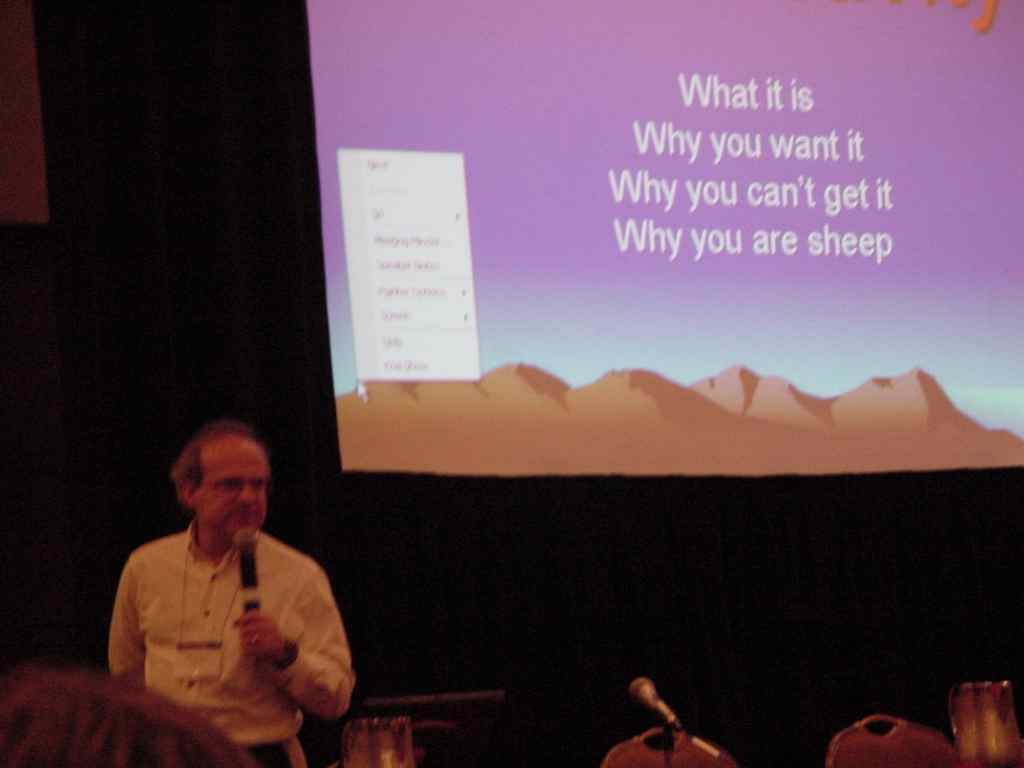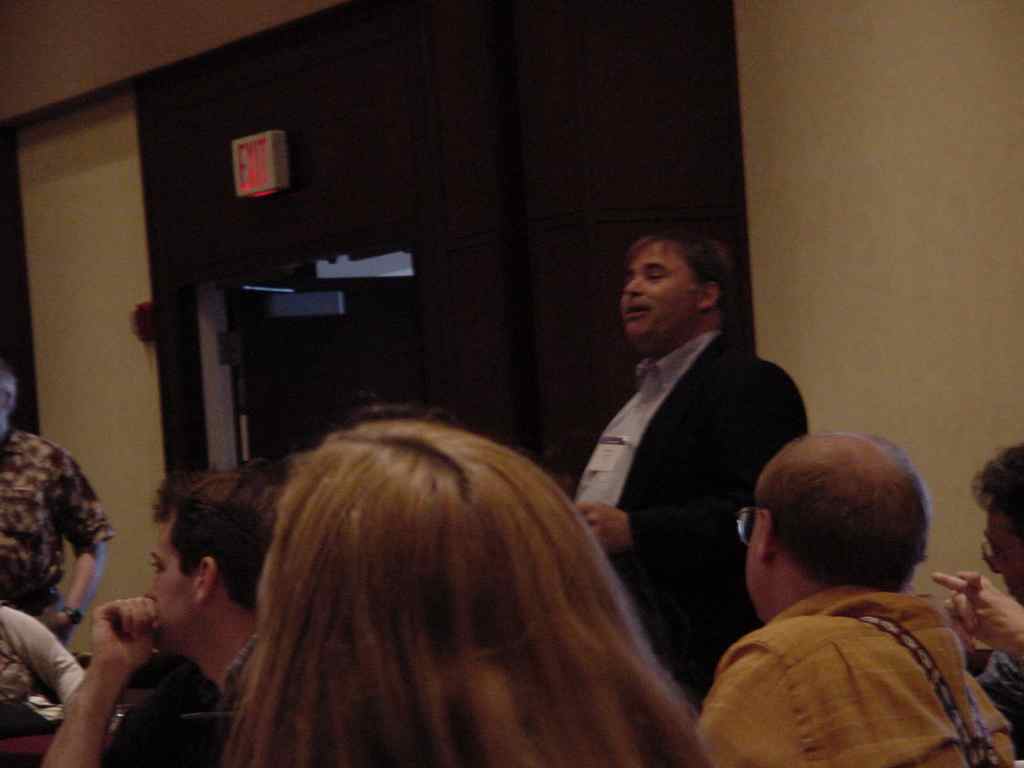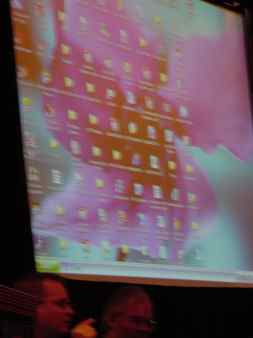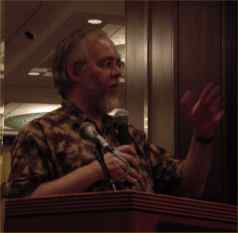Connectivity 2002 – Tuesday Morning
Connectivity 2002 – Tuesday Morning
The most visible initial fact about Connectivity 2002 is that there aren’t a lot of people here. The room is set up for about 150 people but there are only 30 of us here. [At 10am we’re up to about 50.] On the other hand, we just went around the room introducing ourselves and it seems like a really good group.
Bob Frankston is the conference chair and he’s giving his presentation as we wait for The Dave Farber to show up.
I’m now swapping notes — actually scribbles on 3D paper — with Halley Suitt, about what is and isn’t blogworthy. So, 10 minutes in and I’m already three levels of abstraction beyond where I am. Ack.
Bob Frankston’s explaining his version of Moore’s Law, More’s Law, which says if you want more, you can buy more. That’s what drives Moore’s Law. This argues against subsidizing the delivery of broadband because that destroys the dynamic of building more as the market needs it: if the cable company runs out of bandwidth, it builds more because people will pay more. [Yeah, but subsidizing may kickstart a market and, more important, can get over the inequities of a purely market-driven infrastructure.]

Bob Frankston
Bob’s second slide:
RAGE!
You are hostages!
You can’t choose what to watch
You pay the trolls for “phone calls”
You can’t be seen or heard
They must kill the Internet!You are at the end of the last mile!
Bob, in response to a question, says that the incumbent business model pretends there’s a scarcity of bandwidth so that it can maintain control over access and over prices. But the users are the “unindicted co-conspirators” who go along with this.
Carl Ford, formerly from GTE but now with pulver.com, is standing in the aisle disputing the conspiracy theory. [Chris Herot IM’ed me with this info. He’s reading this blog as it develops. Thanks, Chris!]

Carl Ford protests!
Bob would like to see a decoupling of the network from the services built on it. He thinks the telco’s should actually want to be broken up, if only they were smart enough. The people here from the telco industry are shaking their heads at the idea that it’s stupidity that keeps them from seeing the wisdom of decoupling. If this conference can actually get to the common ground here — for surely it is anything but stupidity that drives this mess — it’ll be truly useful.

Dave Reed (right) – Icon … and Icon-Abuser
David Reed, of End-to-End fame, has announced that his point is that it’s time for us to admit that we don’t know what the business model is. The end-to-end argument says that the network itself should be “stupid” in Isenberg’s phrase in that it ought to do nothing but move bits, and the applications that make sense of those bits ought to be on the edges of the network. The alternative is to build special functionality into the network itself, but every time you do that, you actually make it harder to come up with innovative uses of the network. But that means that the network becomes commoditized which the telcos desperately don’t want to have happen. [This is my summary. Don’t blame Reed.]
Damn! Blogger just hiccoughed and ate two paragraphs of recapping of Reed’s economic model and why Bluetooth failed. Basically, Reed argues that the value in the network comes from the options at the edges where you make bets on innovation that may work. “Optimizing” the network itself for this or that app closes down other options. Reed pointed to Bluetooth and Universal Plug and Play as ways not to do this. Bluetooth came up with app-specific protocols rather than being a “stupid” protocol. Universal PnP tried to anticipate every conceivable app/decide that might come its way, an impossibility.
Reed is saying that pervasive computing will be wireless, so let’s look at it. All the wireless devices will have to be capable of highly flexible connectivity. The situtation is urgent already. It’s not so much about bandwidth…
[Damn. I have to go make a phone call that can’t be rescheduled…]
[Ok, I’m back. Which is as unnecessary as “If you lived here you’d be home now.”] Reed is saying that end users can afford gigabit broadband (currently $2,500-$3,500 and dropping, much less than remodeling a kitchen) as opposed to looking for a business to make that sort of investment. And now we’re all clapping for David… Sorry I missed the center. I am a huge admirer of David’s.

David Reed
Privacy and Spam panel. The connection between privacy and spam is, says the panel chair, Ray Everett-Church (ePrivacyGroup), is that many people assume that the spam they’re getting offering them photos of “barnyard frolics” is actually based on someone knowing something about them. The other two panelists: 1. John Levine, the author of “Internet for Dummies” among other books and a member of Coalition Against Unsolicited Commercial Email. 2. Rob Waters, a lawyer in DC who works on privacy issues.
John: People make two basic mistakes about the Net. 1. They don’t believe that it’s two-way all the time, unlike TV. But he doesn’t mean that The Web is a Conversation(tm). He means that web sites know you’ve been browsing. 2. People don’t believe that no one is in charge. They want police and they want rules.
Rob: Initially, Congress took a hands-off, libertarian attitude towards the Net. Then Ed Markey brought up some privacy rules out of his consumer advocacy. But we’ve confused security and privacy; people’s #1 concern is with identity theft, which is a security issue. Now let’s trash the Hollings bill. It segregates electronic transactions foolishly. It creates data collection with no restrictions on a class action suits. It does no harm…except to everything we do. [Rob has assumed I know more than I do so I’m a little at a loss here. Sorry. (This is the bad part of being in over my head.)]
John: [as if sensing my plight] The bill says spam has to have a return address, it has to have opt out, and there are penalties if they continue spamming you. But opt out is unworkable because there are too many lists and you have too many addresses.
Bob Frankston (who is on the panel as an emeritus): The problem is that we treat email addresses as physical objects. The return address is fictitious. Instead, you can create your own email addresses for each of your personae, from public to higher grade addresses for friends to a gibberish hash for commercial transactions; that’s what Bob does.
John: Yes, an email address is not like a physical address or a phone number; there’s no central, valid list. So, do-not-mail and do-not-call lists are workable because there’s a master database to work against. But not for email.
From the audience: A powerful industry coalition is against privacy safeguards because they want to use personalization software to own more of the customer.
[Isenberg just terminally distracted me from this panel, which is meandering down some paths I don’t find compelling, by taking a headline from today’s Globe — “Cancer Study Backs Ovary Removal” — and writing “Headlines You Won’t See: Cancer Study Backs Testicle Removal.”]
Panel is over. Lunch is around thetemporal corner…
Categories: Uncategorized dw









